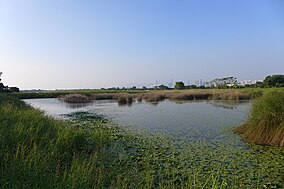This article needs additional citations for verification. (August 2007) |
| Mai Po Marshes | |
|---|---|
 Fish pond in Mai Po | |
Map of Hong Kong | |
| Location | San Tin, Hong Kong |
| Nearest city | Yuen Long |
| Coordinates | 22°29′56″N 114°02′45″E / 22.499°N 114.0458°E |
| wwf | |
| Official name | Mai Po Marshes and Inner Deep Bay |
| Designated | 4 September 1995 |
| Reference no. | 750[1] |
| Mai Po Marshes | |||||||||||||||
|---|---|---|---|---|---|---|---|---|---|---|---|---|---|---|---|
| Traditional Chinese | 米埔濕地 | ||||||||||||||
| Simplified Chinese | 米埔湿地 | ||||||||||||||
| |||||||||||||||




Mai Po Marshes (Chinese: 米埔濕地; Hong Kong Hakka: Mi3bu4 Sip5ti4) is a nature reserve located in San Tin[2] near Yuen Long in Hong Kong. it is within Yuen Long District.[3]
It is part of Deep Bay, an internationally significant wetland that is actually a shallow estuary, at the mouths of Sham Chun River, Shan Pui River (Yuen Long Creek) and Tin Shui Wai Nullah. Inner Deep Bay is listed as a Ramsar site under Ramsar Convention in 1995, and supports globally important numbers of wetland birds, which chiefly arrive in winter and during spring and autumn migrations. The education center and natural conservation area is 380 acres (1.5 km2) wide and its surrounding wetland has an area of 1500 acres (6 km2). It provides a conservation area for mammals, reptiles, insects, and over 350 species of birds.
The reserve is managed by the World Wide Fund for Nature Hong Kong since 1983 and WWF runs professionally guided visits for the public and schools to the reserve; the Agriculture, Fisheries and Conservation Department has responsibilities for the Ramsar site as a whole. Deep Bay faces threats, including pollution, local urban development plans and rising mudflat levels that perhaps arise from intense urbanization, especially (in recent years) on the north, Shenzhen side of the bay.
In recent years, it housed over 55,000 migrating birds, including Saunders's gull (Chroicocephalus saundersi) and a quarter of the world's Black-faced spoonbill (Platalea minor) population. However, the overall numbers are declining every year. The critically endangered Spoon-billed sandpiper (Calidris pygmaea) is still recorded regularly on migration. The reserve also includes inter-tidal mangroves along with 24 traditionally operated shrimp ponds (called Gei Wai locally) to provide food for the birds. Mai Po Marshes receives some 32,000 visitors annually.
While the area was taken out of the Frontier Closed Area on 15 February 2012, Mai Po Nature Reserve remains a restricted area under the Wild Animals Protection Ordinance (Chapter 170) in order to minimize disturbance to wildlife.
Visitors need a 'Mai Po Marshes Entry Permit' to enter the Reserve. By joining a WWF professionally guided activity and be part of a small group ecovisit, WWF will take care of permits for you.
Individuals can apply for a permit by writing to the Agriculture, Fisheries & Conservation Department of Hong Kong Government. The aforementioned Individual Permits normally take about a week to be processed.
38 mammal species inhabit the reserve, more than anywhere else in Hong Kong. Mai Po is home to one of the highest densities of leopard cat in the territory, however they are nocturnal and rarely seen. Small Asian mongooses are quite common in the reserve, often encountered by visitors near Gei Wai ponds during the day in winter. A small population of Eurasian otters, a locally endangered species, is found in Mai Po.
The marshes also have rich insect biodiversity, housing the endemic Mai Po bent-winged firefly (Pteroptyx maipo) was discovered.[4] Not only was the species new to science, but it was also the first time for the genus Pteroptyx has been recorded in China. To understand the seasonal population changes, distribution and habitat requirements of the species, WWF Hong Kong have been carrying out firefly surveys of the nature reserve.[5] The surveys have also incorporated citizen science participation,[6] and using this approach to further monitor the biodiversity, WWF have incorporated iNaturalist and the City Nature Challenge into activities at their Mai Po centre.[7]
- ^ "Mai Po Marshes and Inner Deep Bay". Ramsar Sites Information Service. Retrieved 25 April 2018.
- ^ "2015 District Councils Election - Summary of the District Council Constituency Areas". Hong Kong Government.
- ^ "District Council Constituency Boundaries — Yuen Long District" (PDF). Electoral Affairs Commission. Retrieved 2021-03-21.
- ^ Yiu, Vor; Cheng, Chui-Yu; Shih, Chun-Hat; Fu, Xin Hua; Ballantyne, Lesley (2011-06-27). "Pteroptyx maipo Ballantyne, a new species of bent-winged firefly (Coleoptera: Lampyridae) from Hong Kong, and its relevance to firefly biology and conservation". Zootaxa. 2931 (1): 8–34. doi:10.11646/zootaxa.2931.1.2. ISSN 1175-5334.
- ^ "Firefly survey at the Mai Po Nature Reserve | WWF Hong Kong". www.wwf.org.hk. Retrieved 2019-06-25.
- ^ Ip, Alex (2018-07-30). "Fireflies (Sort of) Like Lights - The CitizenScience.Asia Journal". Medium. Retrieved 2019-06-25.
- ^ "City Nature Challenge | WWF Hong Kong". www.wwf.org.hk. Retrieved 2019-06-25.
